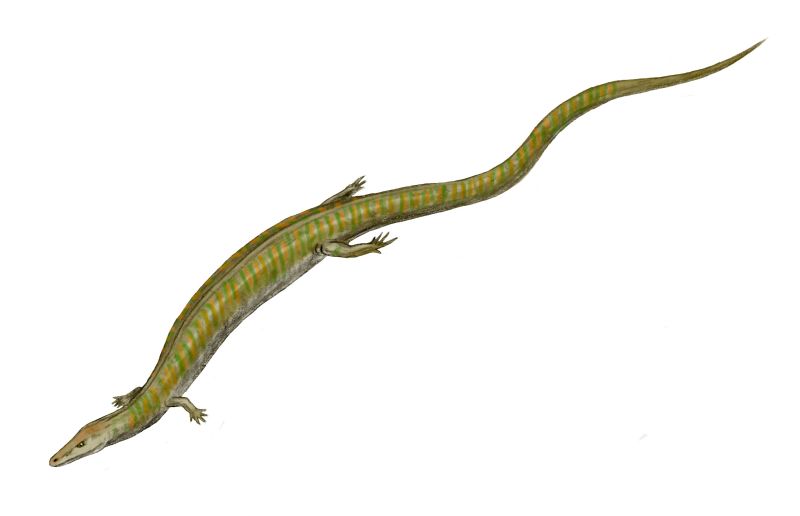- Kaganaias
Taxobox

iage_caption = "Kaganaias hakusanensis"
name = "Kaganaias"
fossil_range =Cretaceous (Cenomanian )
regnum =Animal ia
phylum =Chordata
classis =Sauropsida
subclassis =Diapsida
infraclassis =Lepidosauromorpha
ordo =Squamata
superfamilia =Varanoidea
genus = "Kaganaias"
genus_authority = Evans, et al.2006
species = "K. hakusanensis"
binomial = "Kaganaias hakusanensis"
binomial_authority = Evans, et al.2006 "Kaganaias" (meaning 'Kaga water nymph') is an
extinct genus of mosasauroidlizard that lived in what is nowJapan during the Early Cretaceous. "Kaganaias" was semi-aquatic and is the only known aquaticsquamate to be found inAsia and is also the only known aquatic squamate known from before theCenomanian stage of the Cretaceous. It is also the first to be found in an inland area, instead of on the coast where aquatic squamates are commonly found.Evans, S.E., Manabe, M., Noro, M., Isaji, S. & Yamaguchi, M. (2006). "A Long-Bodied Lizard From The Lower Cretaceous Of Japan." "Palaeontology", 49.6, 2006, pp. 1143–1165.] Its generic name is derived fromKaga Province , the old name for theIshikawa Prefecture where the specimens were found, while the species name "hakusanensis" comes from the mountain that gives its name to Hakusan the city near its find site. The geological formation in which the specimens were found, theTetori Group , stands alongside theTetori River and has been the site of numerous other finds includingmollusc s,dinosaur s,fish andpterosaur s.Although "Kaganaias" is known to be in the Mosasaur family, it is unclear where; it has been assigned to
Platynota (Varanoidea ) for the time being.Description
"Kaganaias" was small (roughly half a meter long), agile and had a long body. Like most of its semi-aquatic kind, "Kaganaias" had reduced limbs to aid in its aquatic activities. "Kaganaias" is known from two specimens; the
holotype specimen was a partial skeleton, comprised of numerous ribs, vertebrae and parts of the limbs and tail, whilst the secondary specimen had extra ribs and sections of theskull also, notably parts of themaxilla . The body of "Kaganaias" was both long and broad across the chest, but was predominantly flat. Despite being classified as a lizard, "Kaganaias" has numerous snake-like features.Sexual dimorphism may have been present in the species, but this is uncertain due to the paucity of data."Kaganaias" lived in what was a fertile, inland
swamp -like region of Japan, possibly a large floodplain which was covered with water for most of the year. The fossil itself was discovered by a construction team preparing to lay down a new tunnel through a fossil cliff in1997 ."Kaganaias" almost certainly moved through the water using a snake-like swimming motion, using its short hind legs to navigate. "Kaganaias" probably fed on other small vertebrates or molluscs which have been found in the surrounding area, but this has yet to be confirmed by the results of the examination of the fossil's faecal remains.
References
External links
* [http://paleodb.org/cgi-bin/bridge.pl?action=checkTaxonInfo&taxon_no=95372&is_real_user=0 "Kaganaias" at The Paleobiology Database] .
* [http://digimorph.org/specimens/Kaganaias_hakusanensis/ "Kaganaias hakusanensis" at Digimorph.org] .
Wikimedia Foundation. 2010.
